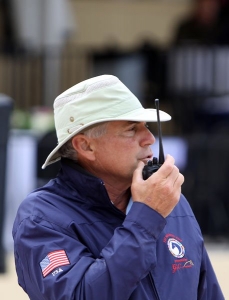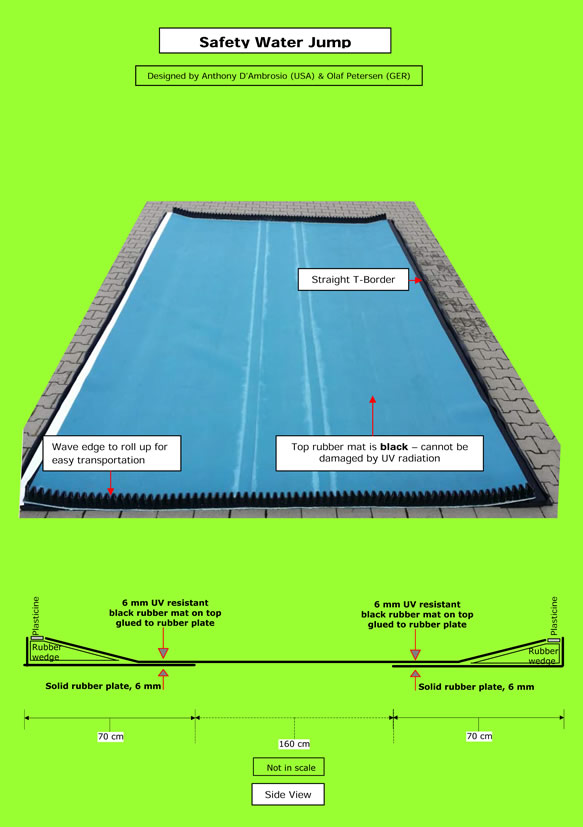Safety Water Jump
 Anthony D’Ambrosio, USA, an excellent course designer and for many years a good friend of mine, had this idea to finally raise the standard of the water jump to a new safety level that corresponds to the current state of technology. In our sport we need a water jump that reduces the risk of injury and increases safety in show jumping as well through its construction and appearance.
Anthony D’Ambrosio, USA, an excellent course designer and for many years a good friend of mine, had this idea to finally raise the standard of the water jump to a new safety level that corresponds to the current state of technology. In our sport we need a water jump that reduces the risk of injury and increases safety in show jumping as well through its construction and appearance.
Anthony and I have exchanged the experiences we have gained in decades as course designers with different water jumps at large and small horse shows worldwide. On this basis, we have constructed a new Safety Water Jump.
We also took into account the current FEI rule: all water jumps must be dug into the ground. The old practice to lay water jumps on the ground is no longer allowed.
In addition, the era of concrete water jumps permanently positioned in the arena may be over. Today we work with portable rubber water jumps, and we change the location at least from year to year, and sometimes we dig it in at different places within one horse show.
Fore criteria had priority for us when we constructed the new safety water jump:
1. Reducing the depth
In the past, most injuries occurred in water jumps that were simply too deep. I myself had been witness years ago in Dublin when a horse of the Irish Team in the Nations Cup jumped into a newly created water jump that was 40 cm deep. Result: fracture of the leg. When landing in deep water jumps horses quickly lose their footing, and horse and riders fall.
We course designers consider it very important that water jumps are not built deep but as flat as possible. That is the reason why Anthony’s and my safety water jump has a depth of only 7.5 cm. If a horse jumps into this flat water it will still remain safe on his legs in most of the cases.
2. Improvement of landing area
Particularly critical for safety is the landing area, especially the area in front of the white plasticine. If a horse jumps too short the forward sliding hoof should never touch a stumbling point, i.e. a straight edge of the water jump. That’s why we have provided rubber wedges on the two long sides. These are 30 cm long ramps that reduce the landing pressure with its flat slope and support a safe landing.
The water jump itself consists of two rubber mats in the bottom area, one 6 mm black solid rubber plate and one 6 mm blue (optional black) rubber mat. The blue mat is glued to the black one in the middle of the tray. But it is open towards “long side”. Thus the rubber wedges lie under the blue mat and are firmly fixed by this.
The rubber wedges also have another function. They are a little lower than the edge of the water jump and have a straight surface on the last 7 cm. The white plasticine that limits the water jump lies on this straight surface.
3. Quick change of jumping direction
The water jump is provided with ramps on both sides. When changing jumping direction – i.e. first competition jumping direction to the left and 2nd competition to the right – only the plasticine and take-off element has to be taken to the other side. Nothing is faster.
4. Fast and Easy Position Change on Show Ground
The safety water jump is bordered on the two long sides by two straight edges (we call these T-edges) while wave edges are attached to the two short sides. The reason is simple. If all the edges are straight the water jump can not be rolled up. One would have to fold it for any rebuilding at a new location or to any warehousing in winter. On the long run this is not good for the T-edges, and it makes it difficult to move this bulky structure.
The lateral wave edge, however, allows to roll up the water jump like a carpet and thus it can be transported easily. Rebuilding during the horse show is made easy and fast.
Our safety water jumps are design protected. They are available in different sizes, and the first products are already in use. Those who still wish to dye water can also get a black instead of blue rubber mat.
For US customers it is easiest to contact Anthony D’Ambrosio ada7777@aol.com. Other interested parties should contact info@olaf-petersen.com.

